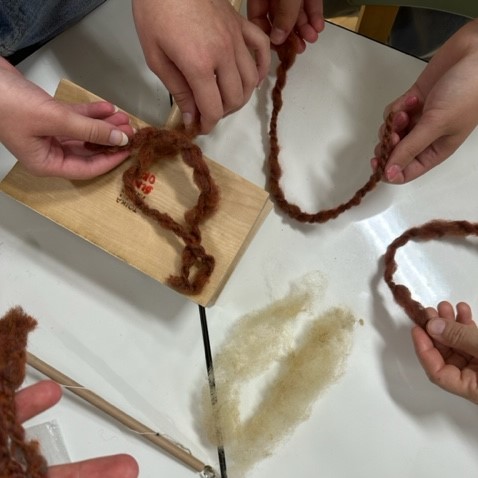Broadening the Scope of Craft Teaching
Exploring Out-of-School Teaching Practices
DOI:
https://doi.org/10.7577/formakademisk.5380Emneord (Nøkkelord):
craft teacher education, craft teaching, formal craft education, nonformal craft education, teaching practiceSammendrag
The focus of Finnish craft teacher education is on educating craft teachers in formal basic education. In this study, the aim was to research craft student teachers’ experiences of teaching practices that were arranged in out-of-school contexts. The data comprised craft student teachers’ (n = 18) written reflections included in their course portfolios. Their teaching practice took place in adult education centres, basic education in arts, older peoples' care homes, youth work centres, centres for people with disabilities, social work centres, museums, craft cafés and clubs and a vocational training institution. The written reflections concerned the students’ expectations at the beginning and those at the end of the teaching practice and were analysed according to the principles of qualitative data analysis. The students found both similarities and differences in craft pedagogy in different contexts. The out-of-school teaching practice broadened their future career perspectives and equipped them with new pedagogical skills.
Referanser
Cresswell, J. W., & Poth, C. N. (2018). Qualitative inquiry and research design: Choosing among five approaches. Sage.
Durukan, Ü. G., Aslan, A., & Bozdoğan, A. E. (2022). Reflections from an out-of-school learning course: The development of pre-service science teachers. Participatory Educational Research, 9(4), 422–444. https://doi.org/10.17275/per.22.98.9.4
Hänninen, V. (2004). A model of narrative circulation. Narrative Inquiry, 14(1), 69–85. https://doi.org/10.1075/ni.14.1.04han
Jarvis, P. (2004). Adult education & lifelong learning: Theory and practice. Routledge Falmer. https://doi.org/10.4324/9780203561560
Jeskanen, S. (2012). Piina vai pelastus? Portfolio aineenopettajaopiskelijoiden ammatillisen kehittymisen välineenä. [Torment or salvation? Portfolio of student teachers for the professional development of student teachers]. Publications of the University of Eastern Finland. Dissertations in Education, Humanities, and Theology, no 38. University of Eastern Finland. https://erepo.uef.fi/bitstream/handle/123456789/11823/urn_isbn_978-952-61-1009-7.pdf?sequence=1&isAllowed=y
Jones, M., & Shelton, M. (2011). How portfolios reflect constructivism. In M. Jones & M. Shelton (Eds.), Developing your portfolio - enhancing your learning and showing your stuff: A guide for the early childhood student or professional (pp. 18–27). Taylor & Francis. https://doi.org/10.4324/9780203835036
Kiilakoski, T. (2003). Laaja-alainen opetusharjoittelu tienä laaja-alaiseen opettajuuteen [Comprehensive teacher training as a pathway to comprehensive teaching]. Kasvatus [Education], 3, 243–256.
Kokko, S. (2022). Orientations on studying crafts in higher education. Craft Research, 13(2), 411–432. https://doi.org/10.1386/crre_00086_1
Kokko, S., Kouhia, A., & Kangas, K. (2020). Finnish craft education in turbulence. Techne serien - Forskning i Slöjdpedagogik och Slöjdvetenskap, 27(1), 1–19. https://journals.oslomet.no/index.php/techneA/article/view/3562
Kröger, T. (2016). Diverse orientations in craft education: Student teachers' conceptions and perceptions. Techne Series A, 23(1), 1–14.
Laiho, A., Nieminen, M., & Tiina Tuijula, T. (2014). Opettajaopiskelijoiden Reflektioita Opetusharjoittelusta: Haasteena Opetustyön Yhteiskunnalliset Reunaehdot [Student teachers' reflections on teaching practice: The challenge of social constraints on teaching]. Aikuiskasvatus, 34(1), 29–42. https://doi.org/10.33336/aik.94072
Pheonix, A. (2017). Analysing narrative contexts. In M. Andrews, C. Squire & M. Tamboukou (Eds.), Sage research methods: Doing narrative research. Sage Publications. https://doi.org/10.4135/9781526402271
Pursiainen, J., Rusanen, J., Raudasoja, E. M., Nurkkala, R., Kortelainen, T., Partanen, S., & Peuna, I. (2019). Selvitys opettajankoulutuksen rakenteesta yliopistoissa. Opetus- ja kulttuuriministeriö [Survey on the structure of teacher education in universities]. Ministry of Education and Culture Publications 2019: 11. http://urn.fi/URN:ISBN:978-952-263-627-0
Raunio, A.-M., & Paju, T. (2022). Käsityön koulutuspolkuja ja taitojen oppimisen elävä perintö [Craft education pathways and a living heritage of skills learning]. Käsi- ja taideteollisuusliitto Taito ry. https://www.taito.fi/wp-content/uploads/2023/05/kasityon-koulutuspolkuja-ja-taitojen-oppimisen-elava-perinto-tutkimusjulkaisu_p-2.pdf
Ropo, E., & Jaatinen, R. (Eds.). (2020). Subject teacher education in transition: Educating teachers for the future. Tampere University Press. https://doi.org/10.61201/tup.734
Rust, R., & Sinelnikov, O. (2010). Practicum in a self-contained environment: Pre-service teacher perceptions of teaching students with disabilities. Physical Educator, 67(1), 33–45.
Saarinen, A., Seitamaa-Hakkarainen, P., & Hakkarainen, K. (2021). Long-term use of ePortfolios in craft education among elementary school students: Reflecting the level and type of craft learning activities. Design and Technology Education, 26(1), 12–28. https://ojs.lboro.ac.uk/DATE/article/view/2911
Schön, D. (1983). The reflective practitioner. How do professionals think in action. Basic Books, Inc., Publishers.
Seitamaa-Hakkarainen, P., & Hakkarainen, K. (2001). Composition and construction in experts' and novices' weaving design. Design Studies, 22(1), 44–66. https://doi.org/10.1016/S0142-694X(99)00038-1
Squire, C. (2017). From experience-centred to socioculturally-oriented approaches to narrative. In M. Andrews, C. Squire & M. Tamboukou (Eds.), Sage research methods: Doing narrative research. Sage Publications. https://doi.org/10.4135/9781526402271
Suter, N., Ardizzone, G., Giarelli, G., Cadorin, L., Gruarin, N., Cipolat Mis, C., Michilin, N., Merighi, A., & Truccolo, I. (2021). The power of informal cancer caregivers’ writings: results from a thematic and narrative analysis. Supportive Care in Cancer, 29(8), 4381-4388. https://doi.org/10.1007/s00520-020-05901-3
TAO ry & TOL ry (2014). Koulutuksen järjestäjälle. Käsityö-oppiaineen asema on vaikea uudessa tuntijaossa [To the training provider. Handicrafts is in a difficult position in the new curriculum]. https://bin.yhdistysavain.fi/1589196/uoNplW9n15smeShlKEy50SFmUY/Koulutuksen%20j%C3%A4rjest%C3%A4j%C3%A4lle%20010414.pdf
Valtioneuvoston asetus yliopistojen tutkinnoista [Government regulation on university degrees] 794/2004, Finlex. https://www.finlex.fi/fi/laki/alkup/2004/20040794#Lidm45843169154464 [22.5.2023]

Nedlastinger
Publisert
Hvordan referere
Utgave
Seksjon
Lisens
Opphavsrett 2023 Professor Sirpa Kokko, Dr. Niina Väänänen

Dette verket er lisensiert under Creative Commons Attribution-NoDerivatives 4.0 International License.
- Forfatteren(e) beholder sin opphavs- og kopieringsrett til eget manuskript, men gir tidsskriftet varig rett til 1) å fremføre manuskriptet for offentligheten i den opprinnelig publiserte digitale form, og 2) å registreres og siteres som første publisering av manuskriptet.
- Forfatteren må selv forvalte sine økonomiske kopieringsrettigheter overfor eventuell tredjepart.
- Tidsskriftet gir ingen økonomisk eller annen kompensasjon for innsendte bidrag, medmindre det er gjort særskilt avtale om dette med forfatteren(e).
- Tidsskriftet plikter å arkivere manuskriptet (inklusive metadata) i den opprinnelig publiserte digitale form, i minst ett dertil egnet åpent tilgjengelig langtidsarkiv for digitalt materiell, som for eksempel i de norske universitetenes institusjonsarkiv innen rammen av NORA-samarbeidet.
Verket vil bli publisert OpenAccess med en Creative Commons 4.0-lisens som tillater alle å lese, dele og tilpasse innholdet, også kommersielt, under lisensvilkårene:
Dette verket må tilskrives/ krediteres på riktig måte, en lenke må gis til CC-BY 4.0-lisensen, og endringer som er gjort må angis på en rimelig måte, men ikke på noen måte som antyder at lisensgiveren støtter deg eller din bruk.



